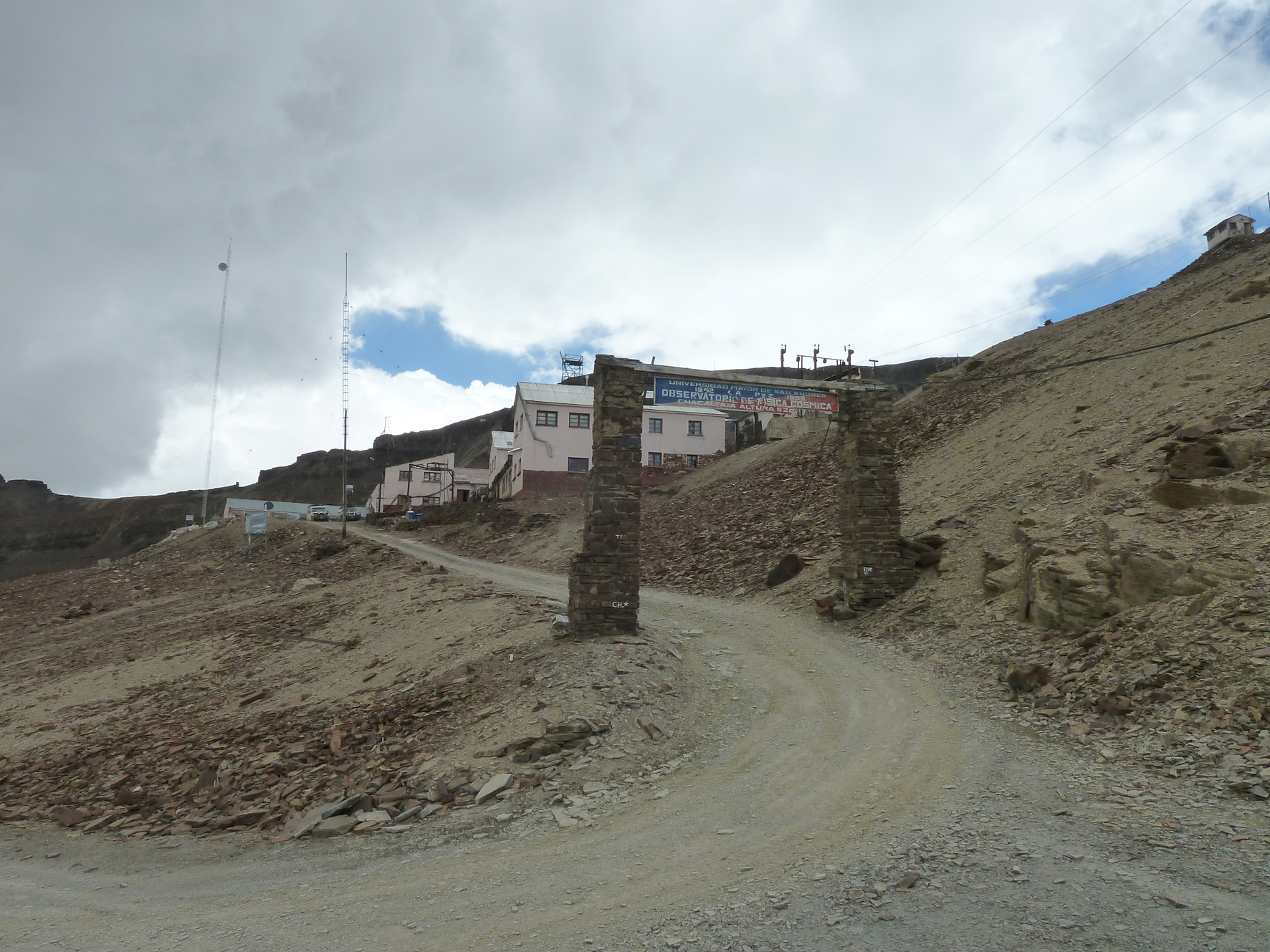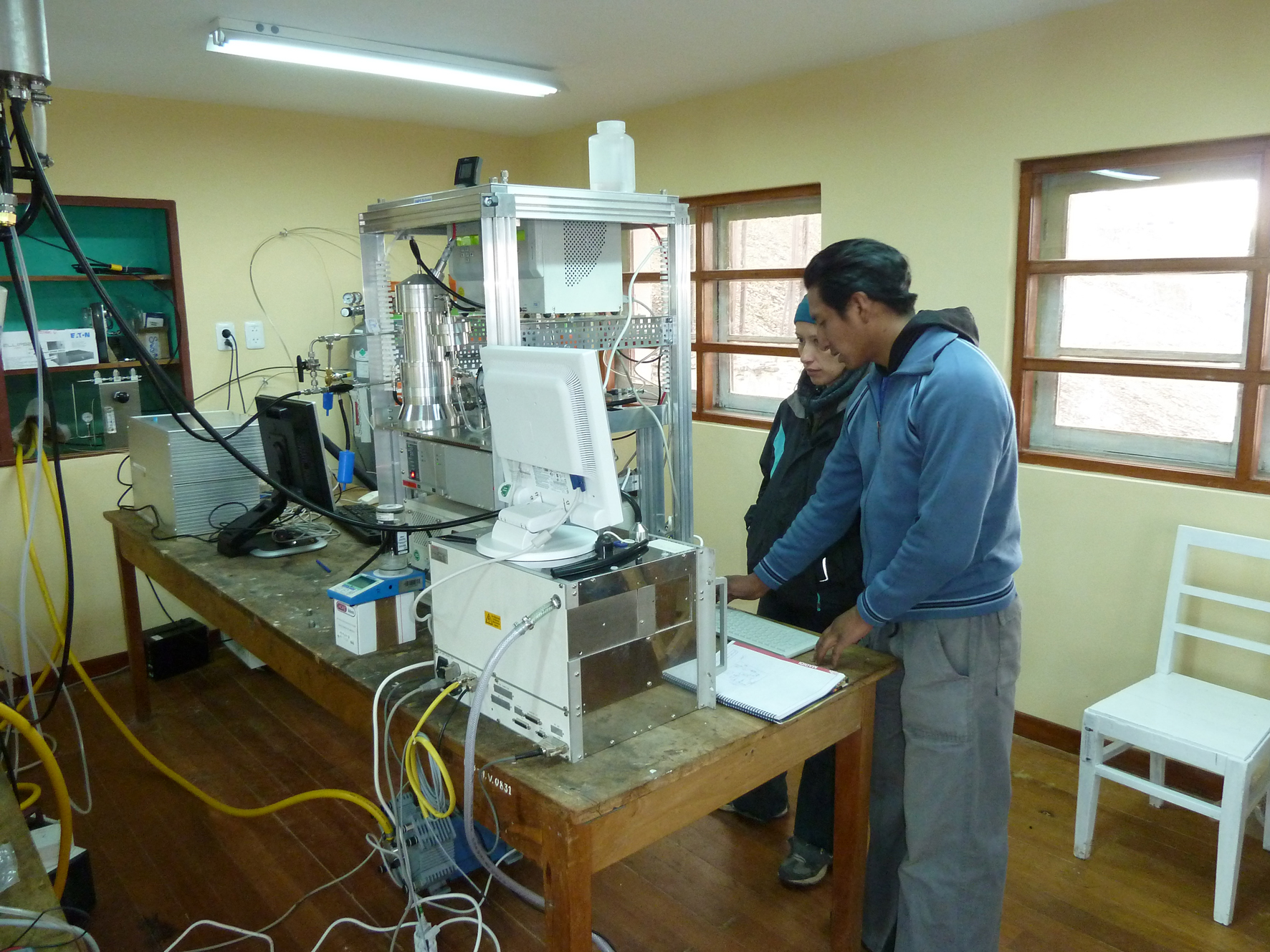Chacaltaya (5240 m) in Bolivia
Leipzig, 24.04.2012
The World highest monitoring station for measuring atmospheric composition change
La Paz / Vienna. For the first time, an atmospheric observatory provides data on the composition of the free troposphere in the tropics in the southern hemisphere on a seasonal to annual basis. The new atmospheric observatory at Mt. Chacaltaya (CHC) in Bolivia is at an altitude of 5240 meters and is the highest such station in the world. First data are available now and will be presented by scientists at the annual meeting of the European Geosciences Union (EGU) in Vienna. The old altitude record was held by the Nepal Climate Observatory - Pyramid situated at an altitude of 5079 meters near the base camp of Mount Everest in the Himalayas.
A number of research groups from France (Grenoble University/LGGE, Laboratoire des Sciences du Climat et de l’Environnement/LSCE and Laboratoire de Météorologie Physique/LaMP), Italy (Institute of Atmospheric Sciences and Climate/ISAC), Germany (Leibniz Institute for Tropospheric Research/IfT), Sweden (Stockholm University/SU) and Switzerland (Paul Scherrer Institute/PSI) have combined their efforts to support the initiative led by the Universidad Mayor de San Andres (UMSA-LFA) to install this unique infrastructure for documenting the variability of the atmospheric composition at Mt. Chalcaltaya. The US NASA Goddard Space Flight Center has joined this group of institutions by helping the LIDAR group at the LFA in implementing a fully functional lidar system in Cota-Cota, at only 22 km in straight line, from Chacaltaya. For this region, information on the atmospheric composition is largely unknown due to the lack of observations. Measurements at the station started in December 2011 and include monitoring of gases (CO2, CO and O3), characterization of aerosol particle properties (absorption and scattering coefficients, number size distribution, chemical composition, and small ions) as well as radiation and meteorology. Aerosol lidar measurements are made from La Paz in support of the overall research effort. The CHC station is part of the WMO-GAW network.
South America is facing dramatic environmental changes linked to deforestation over the Amazon Basin driven primarily by agricultural expansion and logging. Biomass burning activities resulting nowadays dominantly from anthropogenic land-use change are potent sources of CO2 and several Short Lived Climate Forcers (SLCFs). Tropical deep convection introduces both biogenic and pyrogenic aerosols into the free troposphere, where, thanks to a lifetime on the order of weeks, aerosol particles can be transported over long-distances with nearly global impact. The presence of high aerosol loads over the Bolivian Altiplano will likely influence local/regional radiative balance, but also may exert a strong impact on the strength of the convective circulation and hence the precipitation patterns in the arid Altiplano region. The lack of availability of climate and atmospheric data in the region remains, however, a strong constraint on both Climate and Chemistry-Transport modeling efforts.Mt. Chacaltaya is in the Cordillera Real, a mountain chain in the Andean highlands of Bolivia. The peak reaches 5421 meters above sea level. The mountain has long been considered the highest ski area in the world. After the disappearance of the glacier, skiing, however, was terminated. In good weather the view extends to the Titicaca Lake and 30 kilometers to La Paz. The observatory, which is accessible by car, is situated at 5240 meters, just below the summit.. The mountain has already gone down in the history of science: Since the 1940s, there was an observatory for cosmic radiation at the site. The British physicist Cecil Frank Powell, collaborating with the young Brazilian physicist César Lattes, worked on the development of a photographic method for studying of atomic processes, which led to the discovery of the pion.
In recent years, the station was expanded to atmospheric research that began in 2010 and is now part of the "Global Atmosphere Watch Programme" (GAW) of the World Meteorological Organization (WMO). It observes the evolution of the atmosphere to investigate the effects of global change. Aerosol particles, often colloquially referred to as particulate matter, play a large role in the Earth's climate. They absorb and scatter solar radiation. In addition, aerosol particles act as cloud condensation nuclei. The aim of the monitoring network is to monitor the chemical composition of the atmosphere, aerosol particles and long-term physical parameters at a high level of quality. The data obtained are freely available to the scientific community. They are among others used for the study of atmospheric trends for improved predictive models, for the ground calibration of satellite measurements and for discussion and assessment in climate policies.
Publication/Presentation:
First atmospheric observations from the high altitude Chacaltaya GAW station (Bolivia - 5200 m)
http://meetingorganizer.copernicus.org/EGU2012/EGU2012-10350.pdf
(EGU2012, Vienna, Wednesday, 25 Apr 2012, 08:30–08:45 AM)
Contact:
Dr. Marcos Andrade, Universidad Mayor de San Andres, La Paz, Bolivia www.atmos.umd.edu/~mandrade/resume/resume.html
Dr. Paolo Laj, Grenoble University - CNRS, Laboratoire de Glaciologie et Géophysique de l’Environnement (LGGE), Grenoble, France
Prof. Alfred Wiedensohler, Leibniz Institute for Tropospheric Research, Leipzig, Germany
www.tropos.de/info/wiedensohler_a.pdf
Links:
Estación Regional GAW de Chacaltaya: http://www.chacaltaya.edu.bo/index.php?option=com_content&view=category&layout=blog&id=42&Itemid=69
http://orion.scienceontheweb.net/flash/index.html
Global Atmosphere Watch (GAW) of WMO: http://www.wmo.int/pages/prog/arep/gaw/gaw_home_en.html
Institutes:
Universidad Mayor de San Andres (UMSA-LFA): http://www.lfabolivia.org/
Laboratoire des Sciences du Climat et de l’Environnement (LSCE): http://www.lsce.ipsl.fr/
Laboratoire de Météorologie Physique (LaMP): http://wwwobs.univ-bpclermont.fr/atmos/fr/index.php
Institute of Atmospheric Sciences and Climate (ISAC): http://www.isac.cnr.it/
Leibniz Institute for Tropospheric Research (IfT): http://www.tropos.de/
Stockholm University (SU): http://www.misu.su.se/
Paul Scherrer Institute (PSI): http://www.psi.ch/lac/
l’Institut de recherche pour le développement (IRD): http://www.bo.ird.fr/spip.php?page=rubrique_accueil&id_rubrique=334&titre_mot_rub=accueil
NASA/Goddard Space Flight Center (GSFC) http://www.nasa.gov/centers/goddard/home/index.html


